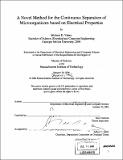A novel method for the continuous separation of microorganisms based on electrical properties
Author(s)
Vahey, Michael D. (Michael David)
DownloadFull printable version (26.41Mb)
Other Contributors
Massachusetts Institute of Technology. Dept. of Electrical Engineering and Computer Science.
Advisor
Joel Voldman.
Terms of use
Metadata
Show full item recordAbstract
Increased throughput in the techniques used to engineer new metabolic pathways in unicellular organisms demands similarly high throughput tools for measuring the effects of these pathways on phenotype. For example, the metabolic engineer is often faced with the challenge of selecting the one genomic perturbation that produces a desired result out of tens of thousands of possibilities. This thesis proposes a separation method - iso-dielectric separation, or IDS - which separates microorganisms continuously based on their dielectric properties. This technology would enable high throughput screening of cells based upon electrically distinguishable phenotypes. Iso-dielectric separation uses dielectrophoresis (DEP) and media with spatially varying conductivity to separate cells based upon their effective conductivity. Our target application is the separation of Escherichia coli based upon the amount of the intracellular polymer poly(hydroxybutyrate) that each cell contains. This thesis discusses the modeling, design, fabrication, and testing of an IDS device.
Description
Thesis (S.M.)--Massachusetts Institute of Technology, Dept. of Electrical Engineering and Computer Science, 2006. Includes bibliographical references (p. 101-103).
Date issued
2006Department
Massachusetts Institute of Technology. Department of Electrical Engineering and Computer SciencePublisher
Massachusetts Institute of Technology
Keywords
Electrical Engineering and Computer Science.